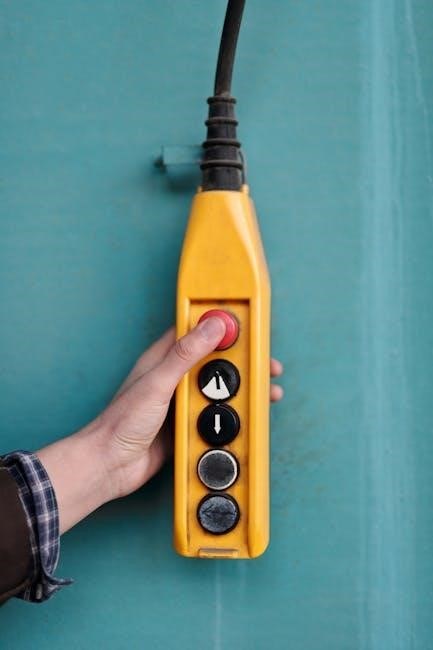The State Operations Manual (SOM) Appendix PP provides critical guidance for surveyors and long-term care facilities, ensuring compliance with CMS regulations and promoting resident-centered care.
1.1 Overview of the State Operations Manual
The State Operations Manual (SOM) serves as a comprehensive guide for surveyors to assess compliance with CMS regulations in healthcare facilities. It outlines procedures for evaluating quality of care, resident safety, and operational standards. Appendix PP specifically focuses on long-term care facilities, detailing survey protocols, resident-centered care practices, and enforcement actions. The manual ensures consistent oversight, promoting compliance and improving care outcomes for residents.
1.2 Importance of Appendix PP in Long-Term Care Facilities
Appendix PP is crucial for long-term care facilities as it sets standards for quality care and safety, ensuring compliance with CMS regulations. It guides surveyors in assessing facilities, focusing on resident-centered care, staff responsibilities, and deficiency identification. By adhering to Appendix PP, facilities can maintain high care standards, protect resident rights, and avoid enforcement actions, ultimately enhancing overall resident well-being and operational integrity.

Purpose and Scope of Appendix PP
Appendix PP outlines CMS regulations, providing surveyors with guidance to assess compliance in long-term care facilities, ensuring quality care standards and regulatory adherence are maintained effectively.
2.1 Objectives of the Guidance Document
Appendix PP aims to ensure long-term care facilities meet CMS standards by providing surveyors with clear guidance on evaluating compliance, focusing on resident-centered care, and safeguarding resident health and safety. It outlines procedures for identifying deficiencies and documenting non-compliance, ensuring consistent enforcement of regulations. The document also addresses handling illegal drugs and confiscating hazardous items, offering a framework for surveyors to assess facility responses effectively, thus promoting quality care and regulatory adherence across all facilities.
2.2 Key Areas Covered in Appendix PP
Appendix PP covers essential areas such as resident-centered care practices, infection control measures, and safeguarding resident rights. It addresses handling of illegal drugs, confiscation of hazardous items, and emergency response protocols. The guidance also outlines surveyor responsibilities, deficiency identification, and corrective action plans. Additionally, it emphasizes effective communication and transparency between staff and residents, ensuring a safe and compliant environment. These areas collectively aim to enhance care quality and operational standards in long-term care facilities.

Key Definitions and Terminology
Key terms include “resident-centered care,” “surveyors,” and “deficiencies,” which are critical for understanding compliance standards and operational guidelines outlined in Appendix PP.
3.1 Resident-Centered Care
Resident-centered care emphasizes individualized attention, respecting residents’ preferences and needs. CMS guidelines require facilities to implement care plans tailored to each resident, ensuring their dignity and well-being. This approach involves active resident participation in care decisions, fostering a supportive environment. Surveyors evaluate how facilities integrate these principles into daily operations, ensuring compliance with Appendix PP standards. Effective resident-centered care promotes better health outcomes and higher satisfaction levels among residents.
3.2 Surveyor Responsibilities
Surveyors play a crucial role in ensuring compliance with CMS guidelines by conducting thorough inspections of long-term care facilities. Their responsibilities include evaluating resident care plans, observing facility practices, and identifying deficiencies. They must assess how facilities respond to incidents, such as illegal drug possession or hazardous items, ensuring resident safety and well-being. Surveyors document findings and provide feedback to facilities, helping them meet Appendix PP standards and maintain quality care delivery.
3.3 Deficiency Identification and Reporting
Deficiency identification and reporting are key processes in Appendix PP, ensuring non-compliance issues are addressed. Surveyors document deficiencies using standardized criteria, focusing on resident health and safety. Reports detail findings, citing specific regulations violated. Facilities receive these reports and must implement corrective actions to resolve issues promptly. Timely and accurate reporting ensures accountability and improves care quality, aligning with CMS standards for long-term care facilities. This process is vital for maintaining regulatory compliance and resident well-being.

Regulatory Background and Updates
Appendix PP aligns with CMS regulations, ensuring long-term care facilities meet federal standards. Recent updates refine guidance, enhancing care quality and safety for residents.
4.1 CMS Regulations for Long-Term Care Facilities
CMS regulations for long-term care facilities are outlined in Appendix PP, ensuring adherence to federal standards. These regulations focus on resident-centered care, safety, and quality of life. Facilities must comply with specific requirements regarding staffing, care plans, and environmental safety. Surveyors assess compliance during inspections, identifying deficiencies that impact resident well-being. CMS updates these regulations periodically to reflect evolving care standards and industry best practices, ensuring continuous improvement in care delivery.
4.2 Recent Revisions to Appendix PP
Recent revisions to Appendix PP aim to enhance clarity and strengthen guidelines for long-term care facilities. Updates include new protocols for handling illegal drugs, improved procedures for confiscating hazardous items, and expanded criteria for identifying substandard care. These changes reflect CMS’s commitment to advancing resident safety and quality of life. Facilities must adapt to these revisions to maintain compliance, ensuring they meet the latest regulatory standards and provide optimal care for residents.

Roles and Responsibilities
Surveyors and facility staff play key roles in ensuring compliance with CMS regulations. Surveyors evaluate adherence, while facility staff implement guidelines to maintain quality care and safety standards.
5.1 Surveyors’ Roles in Ensuring Compliance
Surveyors play a critical role in ensuring compliance with CMS regulations by evaluating long-term care facilities. Their primary responsibilities include conducting on-site evaluations, reviewing policies, and observing care practices. They assess adherence to resident-centered care standards, ensuring facilities prioritize resident safety and well-being. Surveyors also identify deficiencies, document findings, and determine corrective actions. Their work is essential for maintaining quality care and protecting residents’ rights, as outlined in Appendix PP of the State Operations Manual.
5.2 Facility Staff Responsibilities
Facility staff are responsible for adhering to SOM Appendix PP guidelines, ensuring resident-centered care and safety. They must maintain accurate records, follow care plans, and communicate effectively with residents and families. Staff are expected to identify and report risks, such as hazardous items or illegal drugs, and take prompt action to protect residents. They must also cooperate with surveyors during evaluations and implement corrective measures to address deficiencies, ensuring compliance with CMS standards and promoting a safe, respectful environment for all residents.

Survey Process and Procedures
The survey process involves evaluating compliance with regulations through resident-centered assessments and standard tasks, ensuring facilities meet quality care and safety standards as outlined in Appendix PP.
6.1 Resident-Centered Surveys
Resident-centered surveys prioritize individual needs and preferences, focusing on their experiences and well-being. Surveyors engage with residents through observations and interviews to ensure their voices are heard. Facilities are assessed based on how they adapt care to meet unique resident needs, fostering a person-centered environment. This approach ensures compliance with CMS standards while promoting dignity and quality of life for all residents.
6.2 Standard Survey Tasks and Expectations
Standard survey tasks involve a comprehensive evaluation of facility compliance with CMS regulations. Surveyors review documentation, observe care practices, and interview residents and staff. They assess adherence to infection control, medication management, and resident rights. Facilities are expected to demonstrate consistent quality care and safety standards. Surveyors also identify deficiencies and provide feedback for improvement. The process ensures accountability and promotes a safe, respectful environment for all residents.

Identifying Deficiencies
Deficiencies are identified through evaluations of care quality, safety, and regulatory compliance. Surveyors assess adherence to standards, documentation accuracy, and resident outcomes to determine substandard care.
7.1 Criteria for Determining Substandard Care
Substandard care is identified when facilities fail to meet CMS standards, resulting in harm or risk to residents. Criteria include inadequate staffing, poor infection control, and insufficient supervision. Surveyors assess care quality, resident safety, and compliance with regulations. Facilities must address deficiencies promptly to avoid penalties. Proper documentation and corrective actions are essential to ensure compliance and maintain resident well-being. Substandard care determinations are based on observed conditions and their impact on resident health and safety.
7.2 Documentation Requirements
Facilities must maintain accurate, detailed records to demonstrate compliance with CMS standards. Documentation includes resident care plans, incident reports, and corrective actions. Surveyors review these records to assess adherence to regulations and identify deficiencies. Proper documentation ensures transparency, accountability, and resident safety. Facilities failing to meet documentation requirements risk penalties and enforcement actions. Accurate records are essential for effective communication and compliance, ensuring residents receive appropriate care and support. Timely and thorough documentation is critical for maintaining high standards of care and legal compliance.

Enforcement Actions and Corrective Measures
Non-compliance with CMS standards may result in penalties, fines, or facility closure. Corrective action plans must address deficiencies, ensuring resident safety and regulatory adherence promptly.
8.1 Consequences of Non-Compliance
Facilities failing to meet CMS standards face penalties, including fines, loss of Medicare/Medicaid reimbursement, or closure. Repeated deficiencies may escalate enforcement actions, impacting facility operations and reputation.
8.2 Implementing Corrective Action Plans
Facilities must develop and implement corrective action plans (CAPs) to address identified deficiencies. CAPs should outline root causes, corrective measures, and timelines for resolution. Approval by CMS is required, ensuring compliance. Failure to implement CAPs may result in further enforcement actions. Staff training and monitoring are essential to ensure effectiveness and sustainability of corrective measures, promoting continuous improvement in care quality and regulatory adherence.
Resident Rights and Safety
Appendix PP emphasizes protecting resident rights, ensuring dignity, privacy, and freedom from abuse. Facilities must implement measures to prevent neglect and respond to illegal drug incidents promptly.
9.1 Ensuring Resident Health and Safety
Facilities must prioritize resident health and safety by preventing harm, ensuring proper care, and addressing risks promptly. Staff are mandated to identify and confiscate hazardous items in plain view, such as illegal drugs or weapons, to protect residents. Emergency response plans must be in place, and staff should be trained to handle crises effectively. Compliance with these measures ensures a secure environment, aligning with CMS regulations and promoting residents’ well-being and dignity;
9.2 Handling Illegal Drugs in Facilities
Facilities must have clear protocols for managing illegal drugs, ensuring resident safety and legal compliance. Surveyors evaluate how staff respond to illegal substances, including confiscation and reporting. Proper documentation and corrective actions are required to address incidents, maintaining a secure environment and adhering to CMS guidelines. This ensures the well-being of all residents and upholds facility integrity and accountability. Effective handling of such situations is critical for compliance and resident protection.

Communication and Transparency
Effective communication and transparency are vital in fostering trust and collaboration between residents, families, and staff. Clear dialogue ensures resident needs are met and concerns addressed promptly.
10.1 Effective Communication Between Staff and Residents
Effective communication between staff and residents ensures clear understanding and addresses individual needs. Active listening, empathy, and clear language foster trust and collaboration. Regular updates and open dialogue help residents feel involved in their care decisions. Staff training emphasizes respectful interaction, cultural sensitivity, and accommodating communication barriers. Transparent communication also involves families, ensuring shared goals and informed care planning. This approach enhances resident satisfaction and overall care quality.
10.2 Reporting Incidents and Risks
Timely reporting of incidents and risks is crucial for maintaining resident safety and compliance. Facilities must document and report all significant events to appropriate authorities. This includes adverse events, injuries, or potential risks. CMS guidelines outline specific reporting timelines and procedures. Transparent documentation ensures accountability and informs corrective actions. Proper reporting also supports continuous quality improvement and protects residents from harm. Accurate records help surveyors assess compliance during inspections.

Best Practices for Compliance
Adopt proactive monitoring, staff training, and clear communication to ensure adherence to CMS standards. Regular audits and feedback loops enhance compliance and improve care quality effectively.
11.1 Proactive Risk Management
Proactive risk management involves identifying potential issues before they escalate; Regular audits, staff training, and resident feedback help facilities address risks early. Implementing corrective measures promptly ensures compliance with CMS standards and improves care quality. By fostering a culture of vigilance, facilities can prevent deficiencies and safeguard resident health and safety, aligning with Appendix PP guidelines for long-term care facilities.
11.2 Training and Education for Facility Staff
Training and education are essential for ensuring compliance with Appendix PP. Facilities must provide ongoing programs for staff, focusing on CMS regulations, resident-centered care, and survey processes. Regular updates on policy changes and best practices help staff stay informed. Training should emphasize communication, documentation, and proactive risk management to maintain high standards of care and prepare for surveys effectively.
Handling High-Risk Situations
Facilities must address high-risk situations, such as confiscating hazardous items and responding to emergencies, to ensure resident safety and compliance with CMS regulations.
12.1 Confiscation of Hazardous Items
Facilities are authorized to confiscate hazardous items in plain view that pose risks to residents’ health and safety. This ensures a secure environment and prevents potential harm. Documentation of confiscation is required for accountability, and items must be returned or disposed of appropriately. This process is vital for maintaining safety standards and protecting residents, aligning with CMS regulations and SOM guidance.
12.2 Responding to Emergency Situations
Facilities must have clear protocols for responding to emergency situations to ensure resident safety and well-being. Staff are trained to act swiftly, communicate effectively, and coordinate with emergency services when needed. Proper documentation of incidents and responses is required to maintain compliance with CMS standards. These measures ensure preparedness and accountability, aligning with SOM guidance to protect residents during critical events.
Updates and Revisions to Appendix PP
CMS regularly updates Appendix PP to reflect regulatory changes, ensuring long-term care facilities adapt to new standards and maintain compliance with evolving requirements and guidelines.
13.1 Understanding the Latest Changes
Staying informed about updates to Appendix PP is crucial for compliance. CMS releases memoranda outlining revisions, such as new surveyor guidelines and facility expectations. Recent changes include clarifications on handling illegal drugs in facilities and updated protocols for resident-centered care. Facilities must review these updates to ensure adherence to current standards. Understanding the latest changes helps providers maintain compliance and deliver high-quality care. Regularly checking CMS announcements and updates ensures alignment with regulatory requirements and promotes continuous improvement in care delivery.
13.2 Impact on Facility Operations
Updates to Appendix PP significantly influence facility operations, requiring adjustments to policies and procedures. Changes may involve new protocols for confiscating hazardous items and responding to emergencies. Facilities must train staff on updated guidelines to ensure compliance. These revisions aim to enhance resident safety and care quality, necessitating operational shifts. Proactive adaptation to these changes is essential for maintaining compliance and providing optimal care. Facilities must prioritize staying informed and implementing updates efficiently to meet CMS standards and ensure resident well-being.
The State Operations Manual Appendix PP is essential for ensuring compliance and quality care in long-term facilities, providing clear guidance and shaping future standards for resident-centered operations.
14.1 Summary of Key Takeaways
Appendix PP of the State Operations Manual is a foundational resource for long-term care facilities, emphasizing resident-centered care, regulatory compliance, and surveyor guidance. It highlights the importance of maintaining quality standards, ensuring resident safety, and addressing deficiencies promptly. The manual underscores the roles of both surveyors and facility staff in upholding CMS regulations. By adhering to Appendix PP, facilities can safeguard resident well-being while staying informed about evolving healthcare standards and compliance expectations.
14.2 Future Implications for Long-Term Care Facilities
Appendix PP sets the stage for future advancements in long-term care, emphasizing personalized resident care and regulatory alignment. Facilities must adapt to evolving standards, integrating technology and training to meet compliance demands. Proactive risk management and staff education will be pivotal in navigating upcoming updates. The focus on resident safety and quality care will drive innovation, ensuring facilities remain responsive to emerging challenges and regulatory expectations, fostering a culture of continuous improvement and accountability.




About the author